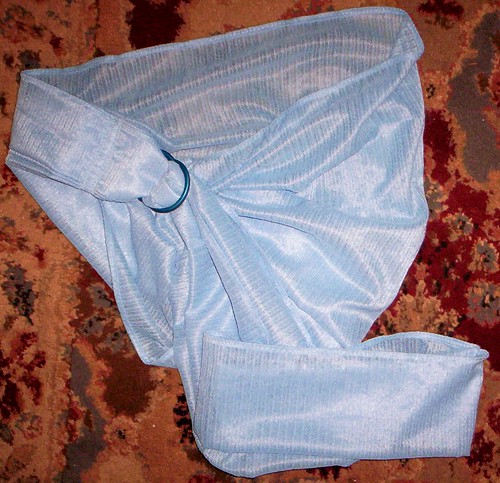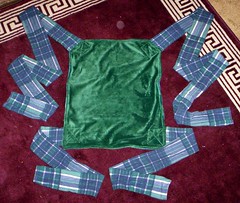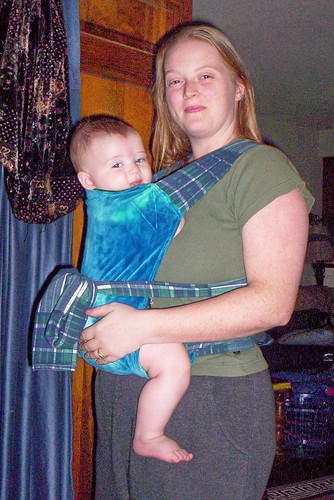My velour lined denim tube and hemp cotton fleece pouch style slings are ideal for cradle carrying a newborn, or for hip-carrying a toddler. I have even found the denim one to be tough enough for carrying a 4-yo child for a short time. For tips on wearing your baby in a tube or pouch style sling, check out www.hotslings.com/pages/techniquesandtricks.php, and for instructions on making your own check out www.ida.net/users/stace/sling.html
I also have a Moby Wrap. Now this is a really fantastic wrap style baby carrier. This wrap is so versitile that I or my husband can both use it, it can carry a child from newborn up to 35 lbs with ease (is weight tested for up to 45lbs), and is made of soft, streachy cotton. For basic instructions on wearing the Moby Wrap, check out www.mobywrap.com/instructions.php
For links to various tying methods appropriate for the Moby, and for the faux-Didymos described below, check out www.thebabywearer.com/articles/HowTo/WrapLinks.htm
I found the greatest deal on some open work knit fabric at Walmart...$1/yard!!...I got 5 yards, and just had to use it to make slings ...
I made a faux-Didymos style and a faux-Maya Wrap style, as well as junior versions of both for my daughters dress-up box, and I think they turned out beautifully!
Here is Kayla modeling both the faux-Didymos and the faux-Maya Wrap...

To make the faux-Didymos, I took The 5 yards of fabric and cut the whole thing exactly in 1/2 along the full length of the material. I then cut off the last 2 1/2 feet or so from the length of one section (I'm short, LOL) and hemmed the large piece around with a 1/2 inch hem. Done! Easy as pie... You could taper the ends if you like, but with this fabric, I actually like it squared...I just gathered each end into a simple knot, and it looks great.
For tips on different ties with the Didymos style sling, check out www.nandu.hu/English/Practical/babycarrier.htm
For the faux-Maya Wrap (ring sling), I took the remaining half of the full yardage and cut it in half, leaving 2 sections, each 2 1/2 yards long. I hemmed both sections around, giving me 1 Junior size faux-Didymos (pictured below). Taking the other, I folded one end in an even 3 to 4 inch wide zigzag (like a paper fan) and zig-zag stitched across a couple times about an inch in...folded the end down about 4 inches over 2 (2 1/2 inch I think, LOL) welded steel rings and zigzag stitched 3 or 4 times to securely attach them. Done! For ring sling/Maya style wearing instructions, check out www.peppermint.com/mayaslingcarry.htm
I then repeated the steps for the maya on the small reamining piece, using shower curtain loops that snap open (for kid safety) for the Junior faux-Maya Wrap (below)...
Here are Natalie and Madison modeling the Junior versions...

I have a solarveil water sling. This amazing fabric is super lightweight, and fast drying, making it ideal for the pool, beach, or shower. Top that off with amazing sun protection properties...it blocks out 70/80 % of UVA and UVB rays with a single layer, and 90/95% with a double layer. Makes you really wonder why the company doesn't manufacture it anymore. Here's hoping they change their minds! With an ever dwindling supply available, I can't even express how glad I was to get my hands on some!

I also have a Podegi, which is WONDERFUL for backbakc carrying a toddler, but by far my favorite besides the Moby is my Mei Tei:



For more information on various types of slings and baby carriers, check out:
www.kellymom.com/parenting/sling.html
www.tccmaven.com/resources/sling.html
www.thebabywearer.com/lists/HowTo.htm
wearyourbaby.com/



